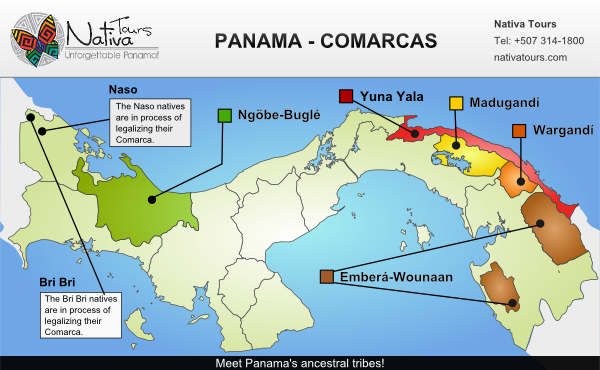
Panama has a diverse group of indigenous cultures that play an important role in the country’s cultural diversity. There are seven distinct indigenous cultures: the Ngöbe, Buglé , Kuna, Emberá, Wounaan, Bribri and Naso. These cultures are further divided into four major Indian groups: the Kuna, the Emberá/Wounaan, the Ngöbe-Buglé (Guaymies), and the Naso Teribe/Bribri.
To a large degree, the indigenous cultures of Panama have maintained a traditional lifestyle and have autonomous control over their own governments. In addition to Panama’s nine geo-political provinces, there are also three “comarcas;” states belonging to the indigenous groups. Comarca (meaning shire or county) is a traditional region or local administrative division and allows the indigenous cultures to practice traditional forms of government without interference.
According to the 2000 census, there are 285,231 indigenous people living in Panama and they make up almost 10% of the overall population.
The Kuna Indians The Emberá / Wounaan The Ngöbe- Buglé The Naso (Teribe)/ The BriBri

There are roughly 50,000 Kuna Indians in Panama with the majority living in the San Blas Islands of the Caribbean coast. There are additional communities found in the jungle of Chucunaque and Bayano as well.
With an estimated population of 25,000 the Emberá inhabit the rainforest in the province of Darien and along the Rio Gatun. There are about 2,600 Wounaan Indians who also live in the Darien rainforest.
Panama’s largest Indigenous group with around 190,000 members, the Ngöbe Buglé represent 63.6% of the country’s indigenous population. The Ngöbe Buglé live in the mountainous areas of Chiriquí, Bocas del Toro, and Veraguas provinces.
There are roughly 3,800 members of the Naso tribe and it is one of the few Native American indigenous groups to have a monarchy. The population of the Bribri barely surpasses 2,500 people.
Both cultures inhabit Bocas del Toro province and live in the coastal zones of the rivers Teribe, Changuinola, San San,Yorkin and Sixaola in the extreme northwest of the country.
